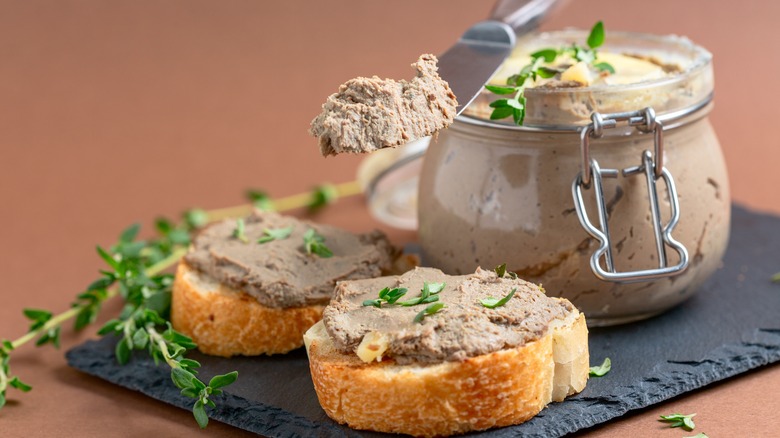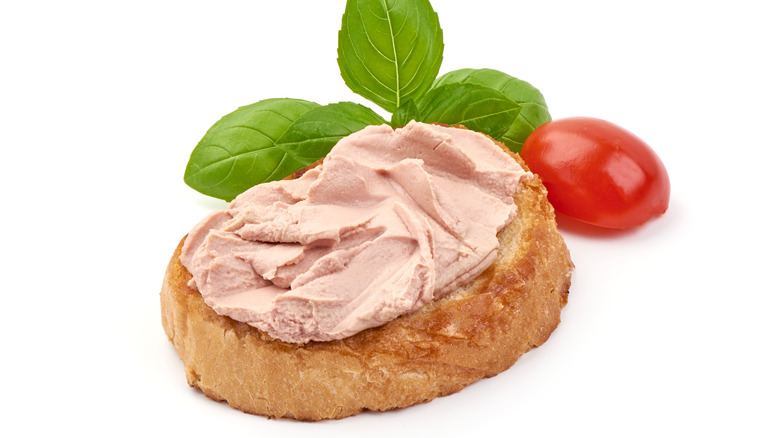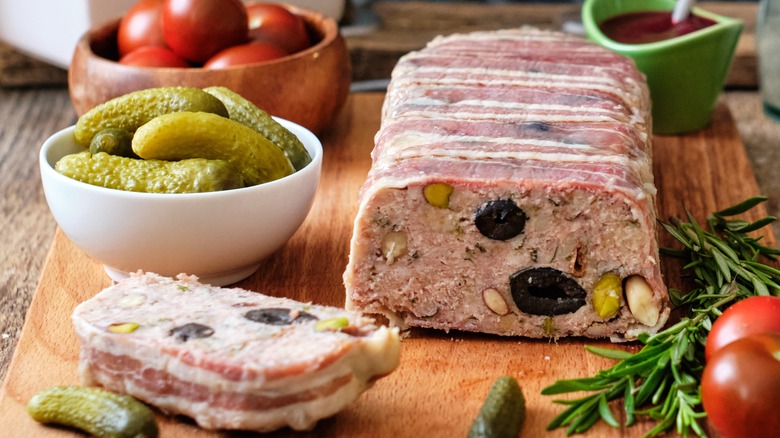Pâté Vs. Terrine: What's The Difference?
What is pâté if not the fancy European spread of pureed liver served with crackers? Generally, pâté has an air of sophistication about it that can elevate any charcuterie board or selection of hors d'oeuvres. In truth, what we imagine when we think of pâté is quite different from the original pâté. The French term pâté has always been somewhat of a loaded term, at times referring to a paste, dough, or crust. Craft Pâté states that pâtés used to be assembled by pastry chefs because they were encased by a layer of pastry or crust. Now, it seems that pâté only refers to the meaty inside of the original pâté sans crust, while pâté en croûte (pâté in crust) specifies that which used to be pâté.
Here is where the confusion comes in: Terrine is yet another seasoned meat mixture, made of a combination of liver, coming from pork, fish, venison, and duck. Richard Olney in Simple French Food swears that any serious French establishment would refer to what we call pâté as a terrine. Traditionalists may abide by culinary terms of years past, but now, terrine and pâté seem distinct in different ways. So what distinguishes one from the other, besides some confusion over terminology?
What is pâté?
As earlier mentioned, pâté used to be liver and meat paste enclosed in a pastry, hence earning it the name pâté, which refers to the dough rather than the meat. However, as the meaning of this term evolved, the dish described became specified as "pâté en croûte," leaving pâté to refer to a specific kind of meat paste. According to Michelin Guide, pâté is made of ground meat or fish, with liver as a traditional binding agent. At times, pâté contains vegetables and herbs for textural contrast and flavor.
The process of making pâté is quite simple, although the cost varies depending on the type of meat you use. House of Caviar and Fine Foods notes that pâté is traditionally made by simmering liver with herbs and seasonings in wine until cooked into a spreadable texture. In this chicken liver pâté recipe, the liver is cooked and then pureed in a food processor with butter for maximum smoothness. This mixture can be served hot, although it is more commonly served cold, like a savory jam to top crusty baguette slices. But what differentiates this paste from terrine, which is also a paste of pulverized meat?
What is terrine?
Terrine often comes in a neatly packed rectangle shape, with clean edges and a smooth surface. This is because terrine is cooked in a terrine, the earthenware pan specifically used for this dish, per Michelin Guide. So, a terrine cannot be a terrine without being cooked in one. This already marks a major difference between standard pâté and terrine – pâté is cooked and then pureed while terrine is cooked in the loaf pan itself. The most popular ingredients in terrine are game meat and pork, due to the flavor and texture of these meats, as opposed to drier and denser choices like beef or chicken, per Spruce Eats.
While pâté can be added to a terrine, a terrine is a specific dish that usually contains layers of meat, vegetables, and sometimes boiled eggs. Making a terrine requires a bit more effort, due to the layering process, whereas a pâté is usually a simple homogeneous paste. This also means that terrine has more variety of textures, with gorgeous pockets of pork fat, or vegetable bits dispersed throughout the loaf. According to Food Republic, one would place the appropriate meat pieces in the terrine, along with vegetables or boiled egg at the center for a beautiful cross-section, and then cook the terrine in a water bath. After it is done cooking, the terrine is usually placed in the refrigerator to cool, and then sliced to serve.


